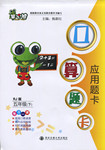题目内容
Siri. The intelligent assistant that helps you get
things done. All you have to do is ask. 
Now you can use your voice to use your iPhone 4S. Just talk to Siri as you would to a person: “Do I need an umbrella?” or “Where’s the closest ATM?” Siri not only understands what you say, it knows what you mean. It figures out the right apps to use to find the right answer. Then, just like a personal assistant, it answers you. Siri makes phone calls, sends messages, schedules meetings, sets reminders, and more. How much more? Just ask, and Siri tells you that, too.
Dual-core A5 chip: the most powerful iPhone
ever. 
Two cores in the A5 chip provide up to two times more power and up to seven times faster graphics. And you’ll feel the effects. iPhone 4S is quick and responsive, which makes all the difference when you’re launching apps, surfing the web, gaming, an doing just about everything. And no matter what you’re doing, you can keep on doing it. Because the A5 chip is so power-efficient, iPhone 4S has outstanding battery life.
FaceTime. It’s even better face-to-face.
FaceTime of iPhone 4S lets you hear a voice and see the face that goes with it—iPhone to iPhone, iPad 2, iPod touch, or Mac over Wi-Fi. So no matter where they are, no matter where you are, you’ll always be there. Making a FaceTime call is just as easy as making a phone call. And it’s even easier with Siri. Just tell Siri “FaceTime with Mom” and you show up, smile and wave hello. You’ll never miss a big event, an important meeting or a good laugh. And who wouldn’t be happy to see your face?
1.The passage is mainly about __________.
A. how to use iPhone 4S B. some models of iPhone 4S
C. some special uses of iPhone 4S D. how to understand some pictures
2.What is special about Siri?
A. It can take photos. B. It can make videos.
C. It can write messages. D. It can answer questions.
3.Which of the following helps iPhone 4S to perform fast?
A.  B.
B.
 C.
C.
 D.
D.

4.Which of the following is NOT TRUE about FaceTime?
A. It can be used together with Siri.
B. It allows you to see the other person’s face.
C. It allows you to hear the other person’s voice.
D. It can only be used between iPhone and iPhone.
1.C
2.D
3.B
4.D
【解析】
试题分析:文章是关于iPhone 4S的一篇科技短文,主要介绍了iPhone 4S的一些特殊功能。这篇文章比较新颖,比较贴近生活。
1.文章主要从Siri,Dual-core A5 chip和FaceTime三个方面介绍了iPhone 4S的一些特殊功能,故选C。
2.根据“just like a personal assistant, it answers you.”可知,Siri可以根据用户提问的问题查找相关应用程序并作出回答。故选D。
3.根据“Two cores in the A5 chip provide up to two times more power and up to seven times faster graphics. ...iPhone 4S is quick and responsive”可知,帮助加快iPhone 4S运行的是A5双核处理器,故选B。
4.根据“iPhone to iPhone, iPad 2, iPod touch, or Mac over Wi-Fi.”可知,FaceTime可以在iPhone, iPad 2, iPod touch, 和Mac之间通用,故选D。
考点:科技类短文阅读

 名师指导期末冲刺卷系列答案
名师指导期末冲刺卷系列答案 开心蛙口算题卡系列答案
开心蛙口算题卡系列答案IMAGINE if there was a device that could do everything for you – wake you up every morning, chat with you and type your e-mails.
The piece of technology in question would be smart, able to tell you about the weather and where the nearest restaurants are.
The good thing is you no longer need to wonder, because something like this already exists. And its name is Siri.
Siri is a voice recognition application designed for Apple products and the concept has been around for almost a year.
When Siri first came out it could only speak English, but now it has “learned” lots of new languages, including Chinese, Cantonese and Taiwanese, reported The Wall Street Journal. So, you can give it orders in your mother tongue.
But how could a cell phone or a computer “hear” what you are saying and understand it? This is all because of voice recognition technology.
When you speak, your voice creates vibrations (振动) in the air – a bit like waves in the water when you throw a rock into the lake. The microphone receives the vibrations and the computer changes them into digital data that is then divided into many parts. They are analyzed one by one to see what pronunciations each part stands for. The computer then puts these pronunciations together into possible words according to its built-in dictionary.
But figuring out the words is far from enough; building words into meaningful sentences is the most difficult part. The computer has to compare what it hears to a large library of known phrases and sentences to determine what the user is saying.
However, people don’t always talk in the most standard way and sometimes make grammatical mistakes. This is why traditional voice recognition software always requires you to remember keywords and to speak in a certain way.
Fortunately, Siri isn’t like that. It’s not just “voice recognition”; it’s “natural language understanding (NLU)”. You can ask it things like “Do I need an umbrella today?” and it will know that you are asking about the weather, according to ABC News.
“The key thing is NLU – understanding what you mean and what you want,” Neil Grant from Nuance, a software company in the US, told The Guardian. “Historically, you had to learn a huge long list of commands . As NLU progresses, you can say what you want in a way that’s natural to you.”
【小题1】What is the function of the first two paragraphs?
| A.To show that invention usually results from need. |
| B.To clear doubts about voice recognition technology. |
| C.To introduce something that offers these helpful services. |
| D.To show how the voice recognition works. |
| A.Changing the received vibrations into digital data. |
| B.Analyzing the digital data to see what pronunciations it represents. |
| C.Putting the pronunciations together into possible words. |
| D.Figuring out meaningful sentences based on the words. |
| A.You can speak in a natural way as you would to a person. |
| B.You can only speak English and Chinese. |
| C.You have to say things in a certain way. |
| D.You have to remember keywords and speak specific commands. |
| A.Siri can record and save what you say frequently into a computer dictionary. |
| B.Siri will fail to understand what you say if you make grammatical mistakes. |
| C.The biggest advantage of Siri is that it’s NLU is rather than just voice recognition. |
| D.Since first applied to Apple products a year ago, Siri has made great improvements. |
| A.the convenience of future life. |
| B.an introduction to the Apple products. |
| C.the working system of voice recognition |
| D.the introduction to Siri |